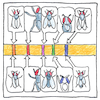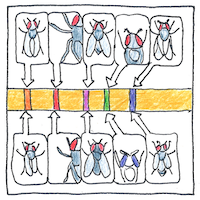William Bateson,
Edith Rebecca Saunders,
Reginald Punnett
genetics

|
Genetic linkage
Most of us multicellular animals have two sets of chromosomes in every cell in our body, but the copies aren’t always identical. They can have alternative forms, called alleles. During meiosis one set of chromosomes go one way and another set go the other way, but it turns out that this is not a random separation. Alleles that are closer together tend to be inherited together.
Other linkages
Bateson was interested in biological variation of insects. Saunders studied the female reproductive organs of flowers. Punnett studied worms, specifically nemerteans. Around 1900, four scientists independently rediscovered Gregor Mendel’s work on the laws of inheritance. Hugo de Vries rediscovered Mendel’s work and introduced the term mutation. Erich von Tschermak rediscovered Mendel’s work and developed disease-resistant cereal crops. Carl Correns rediscovered Mendel’s work and discovered cytoplasmic inheritance. William Jasper Spillman rediscovered Mendel’s work and led the effort to breed a winter wheat for U.S. farmers. Bateson and Punnett helped established the new science of genetics. Punnett wrote the first book to introduce genetics to the public. Saunders’ genetic experiments led her, with Bateson and Punnett, to define the terms allele, homozygous, and heterozygous.
Game of life
Both games and real life have rules, but in life we are talking about probabilities, not certainties. With the same given inputs, the same outcomes would occur, but the inputs are never the same and chance always skews the outcomes. But make the board big enough and zoom out far enough then it seems as though imaginary creatures move of their own free will.



If homologous chromosomes have the same alleles, they are heterozygous. Otherwise, they are heterozygous. All allele may be dominant or recessive. If it is dominant, it is more likely to be inherited. Even so, it takes two to tango.
See also in The book of science:
Readings in wikipedia: